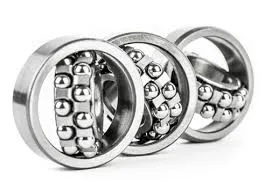
9 月 . 29, 2024 00:36 Back to list
Understanding Tapered Roller Thrust Bearings and Their Applications in Machinery
Understanding Tapered Roller Thrust Bearings
Tapered roller thrust bearings are specialized components designed to handle axial loads, primarily in applications where high performance and durability are critical. These bearings are distinctly engineered to support axial forces while allowing for some radial load capabilities. This unique configuration makes them suitable for a variety of industrial and automotive applications, contributing to their popularity in the engineering and manufacturing fields.
Design and Structure
The design of tapered roller thrust bearings consists of an inner ring, an outer ring, a set of tapered rollers, and a cage that positions the rollers throughout the bearing. The rollers are tapered, allowing them to align with the raceways on both the inner and outer rings, forming a wedge shape. This design enables the bearing to efficiently distribute loads over a larger contact area, which results in lower pressure on the bearing surfaces and reduced wear over time.
The geometry of the tapered rollers allows for better load-carrying capacity compared to other types of thrust bearings. The angle at which the rollers meet the raceways facilitates a larger load-carrying surface, improving the overall strength of the bearing. Furthermore, the ability to sustain higher thrust loads makes these bearings ideal for applications such as gearboxes, automotive differentials, and various machinery where axial force is prevalent.
Applications
Tapered roller thrust bearings are widely used in various sectors, including automotive, aerospace, and heavy machinery. In the automotive industry, they are commonly found in wheel hubs, gear systems, and differentials, where they manage the thrust loads generated during operation. In aerospace applications, the precision and reliability of these bearings are crucial for ensuring the safety and performance of aircraft systems.
tapered roller thrust bearing

Moreover, in heavy machinery and industrial applications, tapered roller thrust bearings are utilized in gear drives within pumps, compressors, and other machinery that requires robust support for axial loads. Their capability to handle high loads while maintaining low friction makes them excellent candidates for these demanding environments.
Advantages
One of the primary advantages of tapered roller thrust bearings is their ability to handle both axial and limited radial loads, providing versatility in application. Additionally, the tapered design allows for improved alignment and reduced friction, which not only extends the lifecycle of the bearing but also enhances overall operational efficiency. The specific geometry and material used in these bearings contribute to their durability, making them resistant to wear and tear over long periods of use.
Another significant advantage is their ease of installation and maintenance. When properly installed, tapered roller thrust bearings can improve performance without requiring frequent adjustments or replacements. This characteristic is especially beneficial in industrial settings where downtime can be costly.
Conclusion
In conclusion, tapered roller thrust bearings play a vital role in modern engineering applications by providing reliable support for axial loads. Their unique design, which combines tapered rollers with robust construction, allows them to efficiently manage heavy loads while minimizing friction. With widespread applications in automotive, aerospace, and industrial machinery, these bearings continue to be indispensable components in the quest for improved performance and durability. As technology advances, the design and material innovations in tapered roller thrust bearings are likely to enhance their efficiency and lifespan further, reaffirming their status as a critical component in various industries.
Latest news
-
Unlocking Efficiency with Spherical Roller Bearings
NewsOct.29,2024
-
The Ultimate Guide to Thrust Ball Bearings
NewsOct.29,2024
-
The Power of Thrust Roller Bearings: Engineered for Excellence
NewsOct.29,2024
-
The Power of Deep Groove Ball Bearings for Your Application Needs!
NewsOct.29,2024
-
The Power and Performance of Cylindrical Roller Bearings
NewsOct.29,2024
-
High-Quality Ball Bearing Manufacturing Machines
NewsOct.29,2024
